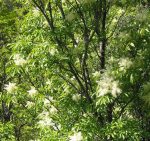 Native to southern Europe and Asia Minor, this deciduous tree is also called manna ash and is a member of the olive family, Oleaceae, that also includes privet, forsythia, and lilac. It grows up to 50′ tall and has a short trunk with smooth, dark gray bark and dark green pinnately compound leaves 5-8″ long with 5-9 leaflets that are ovate to oblong, finely serrated, and 2-3″ long. Terminal and axillary panicles of creamy white, fragrant flowers appear with or after the leaves. The panicles are up to 5″ long and give way to clusters of 2″ long, unattractive winged seed pods called samaras that ripen in the fall and may persist into the winter. Photo Credit Jean-Pol Grandmont Wikipedia
Native to southern Europe and Asia Minor, this deciduous tree is also called manna ash and is a member of the olive family, Oleaceae, that also includes privet, forsythia, and lilac. It grows up to 50′ tall and has a short trunk with smooth, dark gray bark and dark green pinnately compound leaves 5-8″ long with 5-9 leaflets that are ovate to oblong, finely serrated, and 2-3″ long. Terminal and axillary panicles of creamy white, fragrant flowers appear with or after the leaves. The panicles are up to 5″ long and give way to clusters of 2″ long, unattractive winged seed pods called samaras that ripen in the fall and may persist into the winter. Photo Credit Jean-Pol Grandmont Wikipedia
The grain offerings mentioned in the passage below have been identified as a resinous gum derived from trees native to the Levant including manna tamarisk (Tamarix mannifera), prickly alhagi (Alhagi maurorm), and flowering ash (Fraxinus ornus).
Baruch 1:10 (GNT) The Jews living in Babylon wrote a letter to the people of Judah.
“The people wrote: Please use the money we are sending you to buy animals for the burnt offerings and the sin offerings, to buy incense, and to provide the grain offerings. Offer them on the altar of the Lord our God,”
Flowering ash likes full sun and fertile, medium moist, well-drained soil in USDA Hardiness Zones 6-9. It does best where summers are cool, and is somewhat drought tolerant. Plants need regular application of fertilizer and are suceptible to damage by emeralds ash borer, lilac borer, carpenter worm, oyster shell scale, leaf miners, fall webworms, ash sawflies, ash leaf curl aphid, fungal leaf spots, powdery mildew, rust, anthracnose, cankers and ash yellows. Propagation is by seed and grafting. The trees were valued for their spring bloom, shade, and were used as ornamental trees until the emerald ash borer became a problem and now the tree is not recommended for cultivation due to that borer. Fall color ranges from dull yellow to red-purple and is not considered an asset. The sap from the tree has been used medicinally and as a sweetener and anti-caking agent.
The genus name, Fraxinus, is the classical Latin name for the plant. The specific epithet, ornus, is of unknown origin and meaning but may be derived from an old word for ashes.